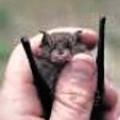15 years of monitoring Eastern Horseshoe Bats
 Australia’s largest known colony of Eastern Horseshoe Bats in the Ourimbah State Forest is in good shape, according to a 15 year research project undertaken by Department of Primary Industries (DPI) scientists.
Australia’s largest known colony of Eastern Horseshoe Bats in the Ourimbah State Forest is in good shape, according to a 15 year research project undertaken by Department of Primary Industries (DPI) scientists.
DPI Principal Research Scientist, Dr Brad Law said the Eastern Horseshoe Bats have been closely monitored since they were first discovered in a previously unknown cave during field surveys in 1995.
“There are very few examples where we know how the status of a species is changing over time, especially for significant populations such as this large bat colony,” Dr Law said.
“While the population has been through a number of troughs in the last 15 years, possibly because of the severe millennium drought of the 2000’s, as of 2013 numbers are almost identical to when the project began at around 9,500 bats.
“The Eastern Horseshoe Bat is named for the intricate shape on its nose (nose-leaf), through which it produces high frequency sounds for echolocation.
“Counting a large colony of bats in a remote location is not an easy task. At the beginning of the study we designed a “gate” of infra-red beams that emerging bats fly through as they leave their cave at dusk.
“The “gate” is connected to a data logger so that bats are counted as they come and go over four consecutive nights. We use the four nights of counting to calculate an average population estimate for the colony for that year.
“Counts are always taken in December when all female Horseshoe Bats congregate from the local area to give birth together and raise their young. The concentration of animals at a single site helps us to produce more reliable counts compared to animals that are spread throughout the forest.
“Eastern Horseshoe Bats feed on insects at night and potentially eat 50 percent of their body weight each night, which is about 500,000 moths per night for the colony.
“For a three month breeding season over summer, that’s around 450 million insects or 3.6 tonnes for this one colony. That’s a considerable ecosystem service being provided for free to the forest.”
Dr Law said the long-term monitoring undertaken by this project is demonstrating a population that is sustaining itself in Ourimbah State Forest.
“With biodiversity declining around the world, and bats in North America collapsing because of a newly emerged disease, it is reassuring to receive positive news about some of our more cryptic, but ecologically important, species,” Dr Law said.
“This project reinforces the value of monitoring the changing status to biodiversity, so that when serious declines are observed, action can be taken.”



